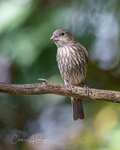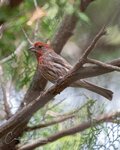

You may have seen this cute couple or one of their friends hanging about your yard recently. The charming house finch is making its home on Long Island, descendants of birds imported from the West and sold as “Hollywood Finches” in the 1940s by New York City pet shops, until a crackdown when shop owners released them to avoid punishment. In the years since, they have thrived, extending their presence well across the Northeast as well as parts of Canada.
You can find out more about the house finch, and many other local birds, at All About Birds, the Cornell Lab of Ornithology website devoted to all things bird. And, they want your help.
In an effort to encourage people with or without prior experience to connect with birds, Cornell lab is sponsoring “Citizen Science: Be Part of Something Bigger,” a project to help identify and count local bird populations and contribute that information to eBIRD, the world’s largest citizen-based science database. Those who sign up will find activities posted and have access to its free birding apps, MERLIN, to identify birds by sight and sound, and eBIRD, a source of useful tools for finding birds and recording those observations on standardized checklists.
Participation is free. Sign up at eBIRD (allaboutbirds.org). Once you’ve registered, you can find more ways to attract these friendly winged neighbors to your yard. To begin, keep a supply of seeds and dried fruits or mealworms in a backyard feeder.
Finches especially like black oil sunflower seeds over larger, striped varieties, as well as dried fruit and millet. Commercial birdseed mixtures are designed with specific local bird species in mind and help to support them.
Community resources such as Forge River Nursery in Mastic (631 399-3777), Shirley Feed and Pet (631 281-2152), and Neptune Feed and Saddlery in Calverton (631 369-0965) offer a wide array of feed choices, as well as other useful products to help develop your yard’s attraction as a bird-friendly destination.
Make sure to place the feeder in a location high enough to give birds easy access, but with enough foliage cover to protect them from potential threats, such as hawks and community cats or dogs. To increase the variety of birds in your yard, consider adding more than one kind of feeder and seed mixture. And, if possible, offering a ready source of fresh water in a clean birdbath is always welcome.
With or without a bird feeder, you can participate in the Citizen Science project. With 10,000 bird species in the world, scientists need help from thousands of people who can observe, record, and report what birds are doing in backyards, neighborhoods, and wild locations.
One event coming up is October Big Day, on Oct. 14 (eBiRD.org/octoberbigday).
Take the eBIRD Essentials Course to make checklists for data scientists and conservationists can use, then consult the MERLIN bird ID app to help identify birds you see. Spend as little as 10 minutes of your day participating with people around the world and contribute to this worldwide checklist used by millions of bird lovers and collect data for scientific study. Download the free eBIRD mobile app, watch birds any time from midnight to midnight on Oct. 14, and record what you see and hear on eBIRD no later than Oct. 17.
Follow results from over 180 countries on the eBIRD October Big Day page. Share your findings on social media #OctoberBigDay.
Coming in December, and just in time for school vacations, the annual Christmas Bird Count is a citizen-science project that has continued for more than a century. Organized groups of experienced and beginner birders participate in a single-day count between Dec. 14 and Jan. 5, 2024. Local counts will be held in Central Suffolk County, the North Fork, Orient, Quogue-Watermill, Sagaponack and Montauk. More information, as well as contacts for registration, can be found at Audubon.org.
Birding is a wonderful way to engage in local exploration and discovery, involve children in a science project close to home, and learn more about what’s going on in our own backyards while contributing valuable information to an international database available to others.
Join Cornell Lab of Ornithology’s effort to study and become part of a community looking for the birds.
Comments
No comments on this item Please log in to comment by clicking here